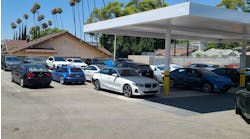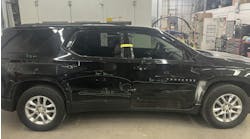Procedures can mean many things in today's collision repair facility. We can — and should — have SOPs (Standard Operating Procedures) in various shop areas. SOPs can standardize the operations so that quality is more consistent and efficiency is improved. While those are not our discussion topics, it's essential to separate those from repair or replacement procedures when focused on vehicle repair. There are many reasons to follow current repair/replace procedures on today's vehicles, and we will cover those as we go along.
It’s time for a change!
Repair/replacement procedures have been around for as long as cars have been. What is different today is that we must use them for every vehicle we have in the shop. Should we have been using them regularly all along? Probably, but as a rule, we didn't because the metals, tools, and techniques were similar. As an industry, we had used the "one-size-fits-all" mindset and replaced a rear body panel in a Mustang, Accord, Malibu, Camry, or Sentra using the same welder, tools, and thought process, as the construction/structural materials were all mostly mild steel, and they were replaced similarly. But those days are over. If you do not research and implement following current procedures specific to that vehicle at that time, you have much catching up to do. Change needs to happen now! If your shop uses current procedures, this will measure your processes and possibly expand them, while improving your accuracy.
Why it's important to use current repair procedures
There are many benefits of using current procedures specific to the vehicle you have in the shop. Beyond some of the apparent reasons involving liability are those of efficiency. Employee retention and recruitment may even improve. For some time, we typically would assess the damage, even if just briefly, and hopefully retrieve the procedures for replacement. I'll give an example. You may briefly look over that vehicle recently brought to your shop and determine the quarter panel needs to be replaced. Let's assume it's torn/ripped about midway up. There is no probable damage to the outer wheelhouse, or anything else, for that matter.
For this discussion, let’s assume the vehicle was slowly backed into by a large flatbed truck in a parking lot, and the rear corner of the bed ripped open the quarter panel like a giant can opener. Easy enough, right? Replace the quarter panel. Blend the rear door, trunk lid, and rear bumper cover, and so on.
But you are trying to stay current, so you go into your trusty computer and pull up the quarter panel replacement procedures. At this point, you have already failed the test. It is not that you are entirely wrong; you will need those specific procedures. The problem is the mindset. There should be a whole host of research done long before you get to that replacement procedure for that panel. I would recommend that research be performed before you ever really think about that quarter panel.
When a ‘simple repair’ is anything but
There is not enough room to cover every aspect of what may seem like a "simple" repair. Unfortunately, I will only be able to go over at a high level what should be considered first. The critical point would be to shift how you approach that repair scenario in your thought process. The research that needs to be done should begin before any disassembly occurs. This is where there may be a considerable change in the process. In the recent past, we would mostly disassemble a vehicle and then look up procedures/documentation to support our repair plan. My notion is that performing research first will better guide your repair plan/blueprint and improve its accuracy. I will go so far as to say there should not be a screw turned or a clip removed on that vehicle until the procedures are in hand!
You may be thinking, "How am I going to know what procedures I need before I disassemble the vehicle?" The answer is you are probably partially correct. It may be true you will be doing research and documentation-gathering during and after disassembly, but you must at the very least first research/obtain some documentation even before disassembly begins. I will give a few examples. Any ADAS, construction/structural materials, and, most importantly, safety-related concerns such as battery-disconnect procedures should be sourced before touching the vehicle. There could be more things to consider researching, but as mentioned before, I'm just going to provide an overview of what needs to be obtained relative to the vehicle you are working on. I cannot cover everything, as there are too many different vehicles/systems today.
Procedures are at the top of the industry’s ‘most improved’ list, but they're also the ‘most changed’
We all know change has come and shows no signs of slowing down soon. Procedures are in the top portion of our industry's "most improved" list. More vehicle manufacturers are doing a better job of providing the information we need to repair today's vehicles. It's in their best interest to have the cars they design and sell to be appropriately repaired, regardless of who is performing the repairs. Occupant safety during a collision is a top concern and should drive our desire to repair vehicles that perform as designed in a subsequent crash. Aside from being more available, procedures are also in the top section of our industry's "most changed" list. We have so many changes in vehicle materials, construction methods, and added safety/comfort features. We also have different procedures for many aspects. Knowing how an ADAS function may be affected as the result of just removing a part/component for a related repair should drive the research component of repair-planning at the very beginning phase. That is just the start of the concerns before working on a vehicle. We'll touch on some more concerns as we go.
Begin with safety: identify high-voltage hazards
Starting with safety in mind, any vehicle you may encounter with a high-voltage system, such as a hybrid or battery-electric, should have research done for precautions on disabling or general handling. Also, please know that vehicles with an electrical system above the standard 12-volt systems will be more common as we move forward. We should all know that orange is the typical color used for high-voltage wiring and other components. I feel confident that most realize the standard 12-volt systems used in almost every vehicle up to today typically have black and red as the primary colors used in those systems for negative (ground) and positive, respectively. It's important to realize there have been and will continue to be vehicles built with a system above the typical 12-volt rating but not quite considered a "high-voltage" system. Those vehicles may use various colors for the wiring and components in those systems. As of late, blue and yellow have been common, but it's anyone's guess as to what the future holds. Also worth noting is that these vehicles typically don't have much in the way of badging to raise awareness, such as a BEV (Battery Electric Vehicle), HEV (Hybrid Electric Vehicle), FCEV (Fuel Cell Electric Vehicle), or PHEV (Plug-in Hybrid Electric Vehicle) may have. The need to research before touching the vehicle begins is the important takeaway here. If you find yourself near a vehicle and see large battery cable-size wiring that is not black or red, I would back away and do some research before proceeding.
Address safety and calibration requirements on the repair plan
Once you have determined what systems the vehicle has, those safety and calibration requirements can be addressed on the initial estimate, repair order, or work order, as you may call it. It is easier to address such things at the beginning versus scrambling midway or at completion. This is a crucial topic; I can't stress enough how important proper research is at the beginning. It takes a LOT longer to form a repair scenario than it ever has in days past. If you've been in this industry for a reasonable amount of time, I'm sure you know where I'm going with this. The days of taking 20 minutes to write an estimate are all but gone in most cases. I see our industry reaching closer to "days" vs. "hours" for proper diagnosis and research when developing a repair plan. All of the aspects mentioned above need to be understood by all parties involved in a repair, regardless of it being shop ownership, insurance personnel, technicians, or even the vehicle owner themselves. Education is the key here. WE CANNOT expect our industry to function as it did 20 years ago. There are way too many differences in these vehicles/repair procedures and the advancement of safety/convenience features to determine the proper collision repair process quickly. Research takes time. Repair or replace?
Once we determine the vehicle is safe to approach and dismantle, we must complete another aspect of the research before disassembly begins. The short version of the next question is, “What types of materials are we working with, and what is allowed?” That question will grow to be quite involved but must be asked before we consider repair-or-replace scenarios. Our industry has a long history of battling repair-versus-replacement of a part or panel. I'm happy to report that as we move forward, a lot of those dilemmas will be solved by the vehicle manufacturers. We all know there are a lot of talented craftspeople in our industry who have the capability of repairing parts/panels that most outside of the industry would be very impressed to witness in person. The problem with having a history like that and the ability to do amazing things is that it can often lead to a situation where something is repaired when it should have been replaced. When considering repairability (straightening) of a part or panel, we must focus on subsequent collisions and the "whys" behind a manufacturer's procedures/guidelines.
Research is the driving force behind repairs vs. replace
The most important takeaway is that research will be the driving force behind repairing that vehicle at your shop. There is a LOT to learn before the pen hits the paper, hence my prior notion that the 20-minute estimate days are over. The construction/structural material documentation and the general guidelines will determine if the repair or replace question is even valid. We already see less repairability when it comes to structural parts, meaning a replace-only description will be more common when it comes to damage to some advanced steels. The questions mentioned above are not typically answered in the specific procedure for that part/panel. So, what would we need today for that "simple" quarter panel replacement we covered earlier? We will say no supplemental restraint systems (airbags or seat belts) are deployed. We already covered the ADAS, structural/construction materials, and battery/SRS system disconnect-related documentation but will include them here as well so you can see the scope of the list.
A basic checklist
I will give you a basic list to start (assuming it's not a hybrid/electric vehicle or has anything above a standard 12-volt system): supplemental restraint system enable/disable, repairs/inspections required after collision guidelines including seat belt inspections etc., battery disconnect procedures, electronic components reset, construction/structural materials diagram, material repairability matrix, welding guidelines/machine set up, body panel gap/tolerance guidelines, welding symbols explanation, welding/bonding guidelines, corrosion protection guidelines, body sealant procedures, undercoating guidelines, body dimensions/opening measurements, soundproofing/insulation/foam guidelines or procedures, steering/alignment measurements/calibrations, scanning pre/post, and ADAS inspections/calibrations (if applicable). Got all those printed yet? If you do, and that may not be all-inclusive depending on what you're doing, remember this is just a basic quarter panel-only replacement.
Now you can print those panel replacement procedures you've been after. You should have a book to place them in already. If you were researching any inner structure, uniside, frame rail, or such, expect that "book" to be much thicker. I purposely listed some of the basics needed for a "simple" panel replacement! It's also important to note that even though there was no airbag deployment in our example, there very well may be specific and lengthy inspections of that system and related components.
The discovery phase
Before beginning any repairs, measurements of the body/frame and steering alignment diagnosis should be a part of the discovery phase. I get challenged a lot on why measurements and a wheel alignment should be early in the process. My answer typically centers around the "we don't know what we don't know" cliche. Unless you diagnose (measure/align), how do you know? I can look at a hood and probably tell you if it's damaged or not. I cannot "look" at steering/suspension system or a structure and tell you if it's within specification; I'm not that talented. I have met several brilliant people in this industry. They are not that talented, either. I think you get my point.
Now that you have that stack of procedures/guidelines, they must remain with the vehicle and be followed accordingly. Sounds simple, right? In your shop, I hope it is. But I often see technicians not taking the time to read and understand what has been given to them. I'm one of the biggest advocates for technicians you will meet, but I'm also a straight shooter. Technicians need to take more time to understand and implement the correct process for that particular repair. When they do, you should see an overall improvement in your shop's performance. Technicians should realize that if administrative staff are doing their due diligence in procedure research, they are equipping that technician to do a safe and proper repair to that vehicle. The owner of that car, truck, or SUV deserves that commitment. If a third-party payer is involved, they also need to understand that this is needed for repairs to be performed properly, and there is a cost associated with this process. Most automakers have subscription capabilities for their repair manuals, which is not a cost of doing business. It is the best way to obtain current information. The time it takes to do research is another consideration.
Document your findings
File documentation is yet another consideration for a collision repair center. The storage of that particular repair information is something the shop should consider. I suggest you refer to your legal counsel for their advice on that matter. You will need to determine a storage method, whether virtual, hard copy, electronic or a combination of those methods.
We all should know by now that the status quo is no more. We hear a lot about change. I will tell you it has already happened on this front. There is no more, "one size fits all." There is no more, "I did that same repair last month." There is no more, "I've been doing this for XX years." It is that realization that should drive the change this industry deserves. It will take all parties involved to have a successful outcome. There will need to be sweeping changes in expectations we've conceded to in the past. It is the only way to provide a safe and quality repair that will endure the test of time and, more importantly, perform as designed in a subsequent collision. It's a new day and a new way, not a choice. Actually, that “day” was "yesterday"!





